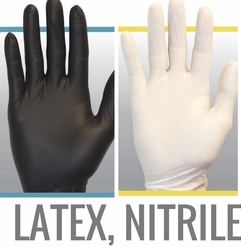Nitrile and latex – pluses and minuses of popular elastic gloves.
The word of a glove comes from the word “finger”. Nitrile or latex gloves are the type of equipment protecting brushes and skin of hands from contact with harmful and dangerous factors of the production environment and labor process.
Disposable gloves – irreplaceable assistants as for workers in the market of cleaning services, in the construction sphere, the food industry, cosmetology and so forth, and for use in life when cleaning (damp and/or dry) and applications in medicine and pharmacology. Depending on a number of features, such, as: material from which the concrete model, existence or lack of dusting, a scope is executed – gloves possess various characteristics.
Right choice of gloves – pledge of comfort and successfully performed work. The first what it is necessary to pay attention to is the material used for production. The most widespread options – latex and a nitrile.
 Nitrile and latex gloves: features and differences
Nitrile and latex gloves: features and differences
Latex gloves
Latex gloves make of latex which represents lacteal juice of rubber-bearing plants, with addition of a set of various ingredients (accelerators, activators, fillers, surfactants, stabilizers, etc.). This type of gloves has long history of application and it is considered the most popular, overtaking nitrile and vinyl models. Latex – the traditional choice of medical institutions. However, despite indisputable pluses of use of this material, latex gloves also possess a number of shortcomings.
Latex Pros & Cons
The advantage which in medicine gloves from latex are especially appreciated is the high level of sensitivity and magnificent elasticity. These characteristics make latex by the best choice for carrying out surgeries. Latex gloves comfortably “sit” on a hand, quickly adapt to a brush and provide reliable capture of the tool (in dehydrated or damp medium).
However there is a shortcoming which seriously affects reputation of latex gloves – it is a possibility of display of an allergy. Natural proteins of rubber quite often act as allergens, causing reaction in people with hypersensibility of skin. The allergy can be shown as at those who use gloves (for example, surgeons or cosmetologists), and at people to whom they contact (patients or clients of beauty shop, etc.).
It is possible to refer to minuses of latex gloves also excessive elasticity that can become a problem in case of use of latex in cosmetology (for example, during the procedure of a sugaring).
Nitrile gloves
Nitrile gloves make of a nitrile – the artificial, synthetic received rubber (other name acrylonitrile-butadiene rubber), and being replacement to natural rubber. The main advantage of nitrile gloves – their absolute hypoallergenicity. This feature of a nitrile makes him by the strong contender of latex habitual to us. However, and here it is necessary to follow several rules recommended by the producer. The first: you do not wear nitrile gloves more than two hours in a row and the second: observe necessary care of skin of hands before use of nitrile gloves.
Nitrile Pros & Cons
Synthetic gloves from a nitrile are a reliable protection against aggressive chemicals. During the work with serious household or industrial chemicals nitrile gloves are more preferable than their analogs from natural latex. Also, a nitrile – stronger material steady against punctures, and the textured surface of gloves provides comfortable and reliable capture.
It is possible to refer their low sensitivity to minuses of nitrile models – in comparison with latex, gloves from a nitrile cannot guarantee to 100% comfortable feelings.

